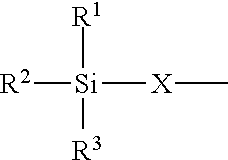High-functional polyisocyanates containing allophanate and silane groups
a polyisocyanate, allophanate technology, applied in the preparation of isocyanic acid derivatives, organic compound preparations, coatings, etc., can solve the problems of lowering the average isocyanate functionality relative, increasing the viscosity of products, and often not being sufficien
- Summary
- Abstract
- Description
- Claims
- Application Information
AI Technical Summary
Problems solved by technology
Method used
Image
Examples
example 1 (
According to the Invention)
216.3 g (0.7 mol) of the silane-group-containing hydroxyurethane A1) and 18.6 g (0.3 mol) of 1,2-ethanediol, corresponding to an amount of 8.6 wt. % relative to the amount of hydroxyurethane Al), were added to 2520.0 g (15.0 mol) of hexamethylene diisocyanate (HDI) at a temperature of 80° C. under dry nitrogen and stirred for 3 hours until an NCO content of 43.8%, corresponding to complete urethanisation, was achieved. Then the reaction mixture was heated to 95° C. and 0.5 g of zinc(II)-2-ethyl-1-hexanoate were added as allophanatisation catalyst. Owing to the exothermic start to the reaction the temperature of the mixture rose to 110° C. After approx. 30 min the NCO content of the reaction mixture was 40.7%. The catalyst was deactivated by adding 1 g of benzoyl chloride and the unreacted monomeric HDI was separated off in a film evaporator at a temperature of 130° C. and under a pressure of 0.1 mbar. 697 g of a virtually colourless, clear allophanate poly...
example 2 (
According to the Invention)
1680.0 g (10.0 mol) of HDI were reacted with 247.2 g (0.8 mol) of the silane-group-containing hydroxyurethane A1) and 15.2 g (0.2 mol) of 1,3-propanediol, corresponding to an amount of 6.1 wt. % relative to the amount of hydroxyurethane A1), by the method described in Example 1. The allophanatisation reaction was started at an NCO content of 40.7% by the addition of 0.5 g of zinc(II)-2-ethyl-1-hexanoate. After reaching an NCO content of 36.3% the reaction mixture was stopped with 1 g of benzoyl chloride and processed as described in Example 1. 673 g of a virtually colourless, clear allophanate polyisocyanate with the following characteristics were obtained:
NCO content:14.9%Monomeric HDI:0.07%Viscosity (23° C.):1550 mPasColour value (APHA):21 HazenNCO functionality:>3.2 (calculated)Silane group content: 8.7% (calculated as SiO3;mol. weight = 76 g / mol)
example 3 (
According to the Invention)
2520.0 g (15.0 mol) of HDI were reacted with 200.9 g (0.65 mol) of the silane-group-containing hydroxyurethane A1) and 31.5 g (0.35 mol) of 1,3-butanediol, corresponding to an amount of 15.7 wt. % relative to the amount of hydroxyurethane A1), by the method described in Example 1. The allophanatisation reaction was started at an NCO content of 43.7% by the addition of 0.5 g of zinc(II)-2-ethyl-1-hexanoate. After reaching an NCO content of 40.7% the reaction mixture was stopped with 1 g of benzoyl chloride and processed as described in Example 1. 631 g of a virtually colourless, clear allophanate polyisocyanate with the following characteristics were obtained:
NCO content:16.1%Monomeric HDI:0.08%Viscosity (23° C.):1250 mPasColour value (APHA):19 HazenNCO functionality:>3.4 (calculated)Silane group content: 6.9% (calculated as SiO3;mol. weight = 76 g / mol)
PUM
| Property | Measurement | Unit |
|---|---|---|
| molecular weight | aaaaa | aaaaa |
| weight | aaaaa | aaaaa |
| adhesion | aaaaa | aaaaa |
Abstract
Description
Claims
Application Information
 Login to View More
Login to View More - R&D
- Intellectual Property
- Life Sciences
- Materials
- Tech Scout
- Unparalleled Data Quality
- Higher Quality Content
- 60% Fewer Hallucinations
Browse by: Latest US Patents, China's latest patents, Technical Efficacy Thesaurus, Application Domain, Technology Topic, Popular Technical Reports.
© 2025 PatSnap. All rights reserved.Legal|Privacy policy|Modern Slavery Act Transparency Statement|Sitemap|About US| Contact US: help@patsnap.com



